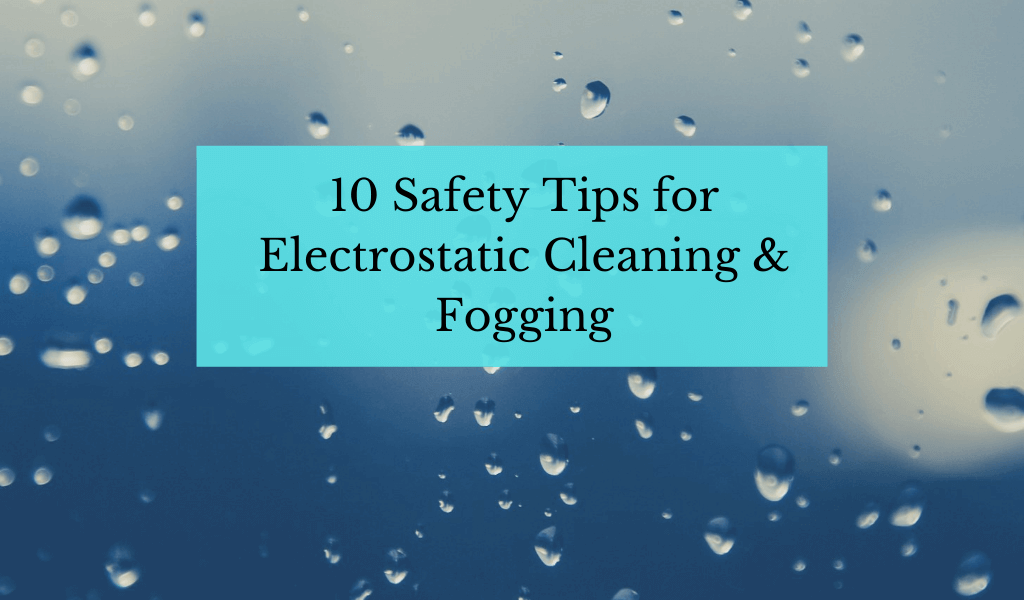Electrostatic cleaning and fogging are gaining popularity. Here’s how you can proceed safely.
Since early 2020 and the spread of Covid 19, electrostatic cleaning has made its presence well known. What was once a specialty service turned into nearly standard practice. Commercial cleaning companies from Boston to Seattle to Lafeyette, Louisiana promoted it on their web pages. Pictures of workers wearing hazmat suits and holding sprayers were on the front page of the New York Times, and the general public could choose from several “professional” disinfectant foggers for under $100 on a popular online shop.
As an actual professional, you know there’s more to it than just grabbing the cheapest sprayer that pops up and throwing some bleach in the reservoir and getting to it. Even if you ignore the possibility of assorted viruses floating in the air, there are still safety considerations to consider with this kind of equipment.
Keep track of inventory, work orders, and more with Janitorial Manager. Learn more today with a free discovery call!

What is electrostatic cleaning?
First, let’s review the different kinds of electrostatic cleaning and disinfecting.
If you want to get technical, electrostatic cleaning should be called electrostatic disinfecting. Cleaning removes dust, dirt, and contaminants from a surface, usually with a cleaning solution and a cloth or something similar. Disinfection is what kills any remaining viruses and bacteria. However, we try not to be sticklers and recognize that many of your clients may ask about electrostatic cleaning (rather than disinfecting).
Then there is an additional distinction between spraying and fogging. Without getting too much into the science, electrostatic sprayers produce a positive charge that attaches to the disinfectant, allowing them to coat more surface area, and thus, kill more viruses and bacteria. The droplets are somewhat heavy and fall from the air fairly quickly.
Foggers, on the other hand, produce a finer mist and can hang in the air longer. That’s a plus if you’re trying to inactivate an airborne virus. Foggers don’t typically have electrostatic capabilities.
Again, though, your clients will likely not know these distinctions. Additionally, many safety precautions are the same, regardless of whether you use a sprayer or fogger, So… We’re just going with “electrostatic cleaning” to keep things simple here. Just know that there are some differences in the actual product and application methods.
Staying safe: 10 Tips to keep in mind when you’re spraying and fogging (for you and your clients)
1. Train your team. Training your team on safety protocols, proper PPE usage, and new equipment is always a good idea. It’s an easy way to keep everyone healthy.
2. Always wear the appropriate PPE. Since these are airborne disinfectants you’re using, you’ll need gloves, a good mask, like an N95, and eye protection. That’s the minimum. You will most likely need a disposable gown, as well.
3. Read the safety sheet. This should be standard operating procedure for any new cleaning chemical or equipment you use, but it’s especially true when you’re spraying these disinfectants into the air where people can breathe them in.
4. Clear the room. Except for anyone applying these disinfectants, clear the space of all people and pets.
5. Follow contact times. The contact time will vary, depending on the disinfectant you use, but always be sure to follow them. This goes for electrostatic cleaning, as well as any other cleaning and disinfecting.
6. Follow the wait time guidelines. This is similar to contact time, but refers more to the time people need to wait before they can reoccupy the room. Read the disinfectant label and safety sheet to determine what these times are. These times will likely be longer if you use a fogger, due to the lighter and smaller droplets that can remain suspended in the air.
7. Use extra caution around food. Kitchens or break rooms will require additional care, as you want to ensure you keep these disinfectants away from food. Of course, that means a fogger is probably out, but it may even be better to exchange a sprayer for a hands-on approach with a cloth.
8. Open windows. Once your electrostatic cleaning is complete, and you’ve allowed the proper contact time to pass, open windows if at all possible to let fresh air into the space. This is generally a smart move for disinfection anyway, as fresh air can help minimize the presence of airborne viruses and bacteria.
9. Communicate. Be very clear with your clients how long the process will take and how long they will need to be out of the facility. That could require a late afternoon or overnight shift for your janitorial team, but you don’t want anyone to have a reaction to the cleaning chemicals you’re using.
10. Rotate employees. If at all possible, rotate the employees who use these sprayers and foggers. That limits the exposure any one person has to airborne chemicals and disinfectants.
Operating a fogger or electrostatic sprayer isn’t anything to worry about. As long as you follow the directions and a few general safety protocols, it’s essentially just another day at the office.
Increase your team’s efficiency, reduce your costs, and improve results. With Janitorial Manager, all this and more isn’t just a dream; it’s your new reality. Contact us for a free consultation right now and see how it works!

